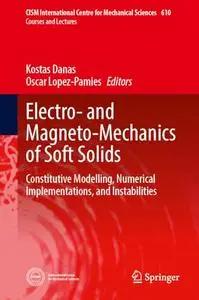Electro- and Magneto-Mechanics of Soft Solids: Constitutive Modelling, Numerical Implementations, and Instabilities by Kostas Danas, Oscar Lopez-Pamies
English | PDF EPUB (True) | 2024 | 185 Pages | ISBN : 3031483502 | 33.4 MB
This book examines the electro- and magneto-mechanics of soft composite materials and structures, and focuses on magnetorheological elastomers (MREs) and dielectric elastomer composites (DECs), which are composite materials that comprise ferromagnetic and high-dielectric/conducting filler nano- and micro-particles embedded in a soft polymeric matrix. This gives rise to a coupled magneto- and electro-mechanical response at the macroscopic (order of millimeters and larger) scale when they are subjected to magneto- electro-mechanical external stimuli. While such MRE and DEC materials and devices can become unstable at some critical electro-magneto-mechanical loading, their response may be well controlled in the post-instability regime. Moreover, recent advances on the complete electro-magneto-mechanical coupling are presented. All those aforementioned features motivate the operation of these devices in this unstable region to obtain controlled pattern formation, soft robotic motion and artificial muscles, controllable band-gap acoustic and electromagnetic properties, energy harvesting as well as actively controlled stiffness (for cell-growth). The book contains four individual chapters covering work on the fundamentals (O. Lopez-Pamies) and the modeling (M. Gei) of electroactive solids, the modeling of magnetoactive solids (K. Danas), and the analysis of elastic instabilities (Y. Fu).



